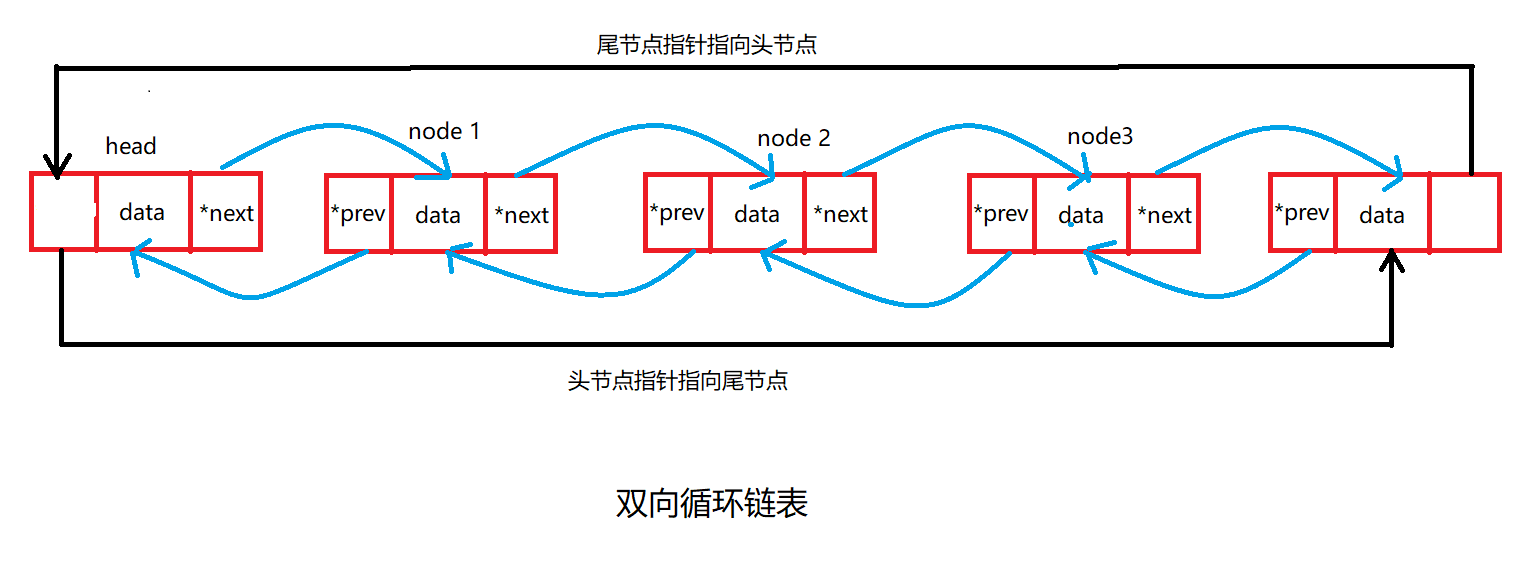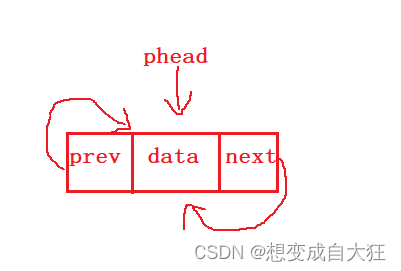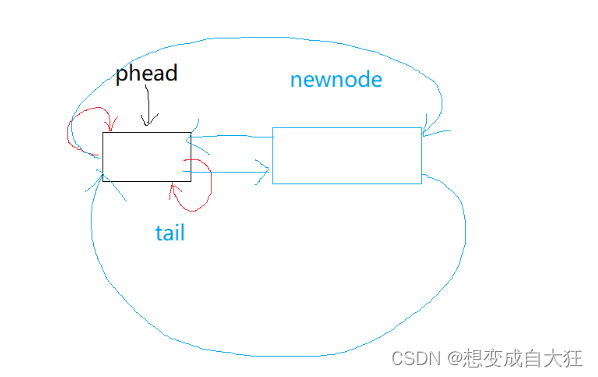张家界网站建设百度一下知道官网
我们在面试中面试官一般都会让我们现场写代码,如果你面试的时候面试官让你十分钟写一个链表,你是不是懵逼了?十分钟写一个链表,怎么可能?事实上是有可能的,十分钟写出的链表也能震惊面试官。
我们学习单链表其实是为了后面学习更高级的数据结构,因为单链表一般不会用来存储数据,只是用来作为更高级数据结构的子结构,如哈希桶、图的邻接表等。单链表看似简单,其实一点也不简单,在进行增删改查操作的时候需要注意很多问题。
在实际中,我们一般使用双向带头循环链表存储数据,因为在链表结构中,双向带头循环链表可以说是链表当中最优的结构了。双向带头循环链表,名字听起来很高大上,看起来很难的样子,其实不是的,它就是一个纸老虎,看起来难,其实它的实现很容易。

双向带头循环链表有一个数据域和两个指针域,第一个指针域指向直接后继,第二个指针域指向直接前驱。表中最后一个节点的第二个指针域指向头节点,头节点的第一个指针域指向最后一个节点,整个链表形成一个环。
双向带头循环链表的结构
typedef int DListDataType;
typedef struct DListNode
{DListDataType* data;struct DListNode* prev;struct DListNode* next;
}DListNode;链表节点的创建
DListNode* BuyListNode(DListDataType x)
{DListNode* node = (DListNode*)malloc(sizeof(DListNode));if (node == NULL){perror("malloc fail");exit(-1);}node->data = x;node->prev = NULL;node->next = NULL;return node;
}链表的初始化

创建一个头节点,让头节点的两个指针域都分别指向自己。
DListNode* LTInit()
{DListNode* phead = BuyListNode(-1);//头节点的data可以为任意值phead->next = phead;phead->prev = phead;return phead;
}链表的打印
void LTPrint(DListNode* phead)
{assert(phead);DListNode* cur = phead->next;while (cur != phead){printf("%d ", cur->data);cur = cur->next;}printf("\n");
}链表的尾插

void LTPushBack(DListNode* phead, DListDataType x)
{assert(phead);DListNode* newnode = BuyListNode(x);DListNode* tail = phead->prev;//保存尾节点(头节点的prev)tail->next = newnode;newnode->prev = tail;newnode->prev = phead;phead->prev = newnode;}链表的尾删
void LTPopBack(DListNode* phead)
{assert(phead);assert(phead->next != phead); // 判断是否为空DListNode* tail = phead->prev;tail->prev->next = phead;phead->prev = tail;free(tail);
}链表的头插
void LTPushFront(DListNode* phead, DListDataType x)
{assert(phead);DListNode* newnode = BuyListNode(x);newnode->next = phead->next;phead->next->prev = newnode;phead->next = newnode;newnode->prev = phead;}链表的头删
void LTPopFront(DListNode* phead)
{assert(phead);assert(phead->next != phead); // 判断是否为空DListNode* pheadnext = phead->next;phead->next = pheadnext->next;pheadnext->next->prev = phead;free(pheadnext);
}在链表中插入节点

// pos位置之前插入
void LTInsert(DListNode* pos, DListDataType x)
{assert(pos);DListNode* prevpos = pos->prev;DListNode* newnode = BuyListNode(x);// prev newnode posprevpos->next = newnode;newnode->prev = prevpos;newnode->next = pos;pos->prev = newnode;
}删除链表中的节点
// 删除pos位置
void LTErase(DListNode* pos)
{assert(pos);DListNode* prevpos = pos->prev;DListNode* nextpos = pos->next;free(pos);prevpos->next = nextpos;nextpos->prev = prevpos;}
判断链表是否为空
bool LTEmpty(DListNode* phead)
{assert(phead);/*if (phead->next == phead){return true;}else{return false;}*/return phead->next == phead;
}计算链表的节点
size_t LTSize(DListNode* phead)
{assert(phead);size_t size = 0;DListNode* cur = phead->next;while (cur != phead){++size;cur = cur->next;}return size;
}销毁链表
void LTDestroy(DListNode* phead)
{assert(phead);DListNode* cur = phead->next;while (cur != phead){DListNode* next = cur->next;free(cur);cur = next;}free(phead);
}以上就是带头双向链表的基本操作,如果想在十分钟之内写出这个链表,只需要在头插,尾插复用
LTInsert(),头删,尾删复用 LTErase(),这样你只需要写出LTInsert()和 LTErase()就等于将头插,尾插、头删,尾删写出来了。
完整代码:
DList.h 接口函数
#include <assert.h>
#include <stdbool.h>typedef int DListDataType;
typedef struct DListNode
{DListDataType* data;struct DListNode* prev;struct DListNode* next;
}DListNode;DListNode* BuyListNode(DListDataType x);
void LTPrint(DListNode* phead);
DListNode* LTInit();
void LTPushBack(DListNode* phead, DListDataType x);
void LTPopBack(DListNode* phead);void LTPushFront(DListNode* phead, DListDataType x);
void LTPopFront(DListNode* phead);
DListNode* LTFind(DListNode* phead, DListDataType x);// pos位置之前插入
void LTInsert(DListNode* pos, DListDataType x);
// pos位置之后插入
void LTErase(DListNode* pos);bool LTEmpty(DListNode* phead);
size_t LTSize(DListNode* phead);
void LTDestroy(DListNode* phead);DList.c 函数的实现
#include "DList.h"DListNode* BuyListNode(DListDataType x)
{DListNode* node = (DListNode*)malloc(sizeof(DListNode));if (node == NULL){perror("malloc fail");exit(-1);}node->data = x;node->prev = NULL;node->next = NULL;return node;
}
DListNode* LTInit()
{DListNode* phead = BuyListNode(-1);//头节点的data可以为任意值phead->next = phead;phead->prev = phead;return phead;
}
void LTPrint(DListNode* phead)
{assert(phead);DListNode* cur = phead->next;while (cur != phead){printf("%d ", cur->data);cur = cur->next;}printf("\n");
}
void LTPushBack(DListNode* phead, DListDataType x)
{assert(phead);//DListNode* newnode = BuyListNode(x);//DListNode* tail = phead->prev;//保存尾节点(头节点的prev)//tail->next = newnode;//newnode->prev = tail;//newnode->prev = phead;//phead->prev = newnode;LTInsert(phead, x);}
void LTPopBack(DListNode* phead)
{assert(phead);//assert(phead->next != phead); // 判断是否为空//DListNode* tail = phead->prev;//tail->prev->next = phead;//phead->prev = tail;//free(tail);LTErase(phead->prev);
}void LTPushFront(DListNode* phead, DListDataType x)
{assert(phead);/*DListNode* newnode = BuyListNode(x);newnode->next = phead->next;phead->next->prev = newnode;phead->next = newnode;newnode->prev = phead;*/LTInsert(phead->next, x);}
void LTPopFront(DListNode* phead)
{assert(phead);//assert(phead->next != phead); // 判断是否为空//DListNode* pheadnext = phead->next;//phead->next = pheadnext->next;//pheadnext->next->prev = phead;//free(pheadnext);LTErase(phead->next);
}
DListNode* LTFind(DListNode* phead, DListDataType x)
{assert(phead);DListNode* cur = phead->next;while (cur != phead){if (cur->data == x){return cur;}cur = cur->next;}return NULL;
}// pos位置之前插入
void LTInsert(DListNode* pos, DListDataType x)
{assert(pos);DListNode* prevpos = pos->prev;DListNode* newnode = BuyListNode(x);// prev newnode posprevpos->next = newnode;newnode->prev = prevpos;newnode->next = pos;pos->prev = newnode;
}
// 删除pos位置
void LTErase(DListNode* pos)
{assert(pos);DListNode* prevpos = pos->prev;DListNode* nextpos = pos->next;free(pos);prevpos->next = nextpos;nextpos->prev = prevpos;}bool LTEmpty(DListNode* phead)
{assert(phead);/*if (phead->next == phead){return true;}else{return false;}*/return phead->next == phead;
}
size_t LTSize(DListNode* phead)
{assert(phead);size_t size = 0;DListNode* cur = phead->next;while (cur != phead){++size;cur = cur->next;}return size;
}
void LTDestroy(DListNode* phead)
{assert(phead);DListNode* cur = phead->next;while (cur != phead){DListNode* next = cur->next;free(cur);cur = next;}free(phead);
}Test.c 测试函数
#include "DList.h"void TestList1()
{DListNode* phead = LTInit();LTPushBack(phead, 1);LTPushBack(phead, 2);LTPushBack(phead, 3);LTPushBack(phead, 4);LTPushBack(phead, 5);LTPrint(phead);LTPopBack(phead);LTPrint(phead);LTPopBack(phead);LTPrint(phead);LTPopBack(phead);LTPrint(phead);LTPopBack(phead);LTPrint(phead);LTPopBack(phead);LTPrint(phead);//LTPopBack(phead);
}void TestList2()
{DListNode* phead = LTInit();LTPushFront(phead, 1);LTPushFront(phead, 2);LTPushFront(phead, 3);LTPushFront(phead, 4);LTPushFront(phead, 5);LTPrint(phead);LTPopFront(phead);LTPrint(phead);LTPopFront(phead);LTPrint(phead);LTPopFront(phead);LTPrint(phead);LTPopFront(phead);LTPrint(phead);LTPopFront(phead);LTPrint(phead);
}void TestList3()
{DListNode* phead = LTInit();LTPushFront(phead, 1);LTPushFront(phead, 2);LTPushFront(phead, 3);LTPushFront(phead, 4);LTPushFront(phead, 5);LTPrint(phead);DListNode* pos = LTFind(phead, 3);LTPrint(phead);LTDestroy(phead);phead = NULL;
}int main()
{TestList1();//TestList2();//TestList3();return 0;
}
